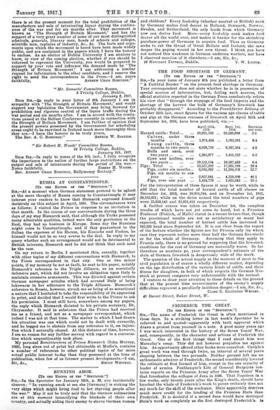THE FOOD SHORTAGE IN GERMANY.
(To THE EDITOR OF THE " SPECTATOR.") Sie,—In your issue of January 6th you published a letter from " A Faithful Reader " on the present food shortage in Germany. Your correspondent does not state whether he is in possession of special sources of information, but, failing such sources, the official statistics reported in the German Press conclusively refute his view that " through the stoppage of the food imports and the shortage of the harvest the bulk of Germany's live-stock has probably disappeared." According to the Frankfurter Zeitung of October 15th last, exact figures for the various age classes of cattle and pigs at the German censuses of live-stock on April 15th and September 1st, 1916, have been published, viz.:—
Horned cattle: Total... ...
Calves, under three months ...
Young cattle, three
April 15th,
1916.
19,921,183 ...
1,974,434
Sept. 1st,
1916.
20,338,950
1,982,891
Increase Der cent.
0.4 months to two years ... 6,029,713 6,307,504 4.6 Bulls and oxen, over
two years ... ...
1,365,877 1,451,122 6.2
Cows and heifers, over two years ...
10,552,154 ... 10,597,433 0.4 Pigs : Total ... 13,337,202 ... 17,261,108 29.4 Pigs, under six months... 9,055,382 ... 11,204.976 23.7 Pigs, six months to one
year 2,857,041 ... 4,230,890 ... 48.1 Pigs, over one year ... 1,424,779 ... 1,825,242 ... 23.1 For the interpretation of these figures it may be worth while to add that the total number of horned cattle of all classes on December 1st, 1913, was 20,994,344, and on December 1st, 1912, 20,182,021; while on the dates named the total numbers of pigs were 25,659,143 and 21,821,453 respectively.
A further census was taken on December 1st, the complete results of which have not yet come to hand, but a Prussian Professor (Frolich, of Halle) stated in a recent lecture that, though the provisional results are not so satisfactory as many had expected, the total number of horned cattle has increased by 162,322 head since September 1st. It is not clear from the report of the lecture whether the figures arc for Prussia only (in which case they represent rather more than half the German live-stocll) or for the whole of Germany. Assuming that they apply to Prussia only, there is no ground for supposing that the live-stock conditions for the rest of Germany are materially worse. So far therefore as numbers go, your correspondent's estimate of the state of German live-stock is dangerously wide of the mark.
The question of the actual supply at the moment of meat to the civil population is of course a wholly different matter, depending on the ago distribution of the various kinds of cattle, and their fitness for slaughter, in both of which respects the German live- stock at present compares very unfavourably with the normal.
1 venture to draw your attention to these details on the ground that at the present time overestimates of the enemy's supply difficulties represent a peculiarly insidious danger.—I am, Sir, &c., CLARE E. ELLINGTON WRIGHT.
41 Dorset Street, Baker Street, W.


































 Previous page
Previous page